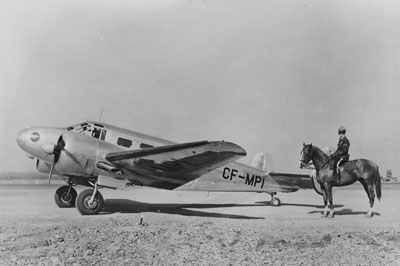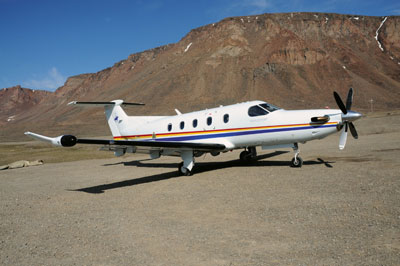
Features
Operations
Maintaining a progressive force
Few images are as iconically Canadian as the Mountie on horseback, in the red serge.
July 10, 2012 By James Marasa
Few images are as iconically Canadian as the Mountie on horseback, in the red serge. More than a century after the force’s formation as an entity for frontier justice, the tools of the Royal Canadian Mounted Police have undergone some upgrades – the red serges have been stored and the horses stabled – but dig past the branding rooted in Canadian identity and we have one of the most progressive police forces in the world.
 |
|
| The RCMP launched its first aircraft in 1937. Seventy-five years later, RCMP Air Services operates more than 30 aircraft, maintains 19 Air Sections and employs 150 people nationwide. Photo: RCMP
|
The First World War officially came to a close in 1918, solidifying a place for aircraft in combat. At that time, the first fledgling airlines were just getting off the ground, and the public had yet to embrace the airplane as the hallmark of transportation it is today. That being so, Commissioner of the RCMP, Aylesworth Bowen Perry, had seen enough to be convinced that the airplane could be a boon to law enforcement on the home front.
Perry recommended that the RCMP form an Air Police service using surplus wartime aircraft, but government support did not materialize. Perry’s vision however, was not in vain. In 1937, four de Havilland Dragonfly biplanes with blue fuselages and yellow wings joined the force along with eight member-pilots, based at Downsview airport. The base moved a few months later to Moncton, N.B. and the Dragonflies were called in to the service of the Royal Canadian Air Force in 1939, leaving the RCMP with a single Norseman aircraft.
Seventy-five years later, RCMP Air Services operates more than 30 aircraft, maintains 19 Air Sections and employs 150 people nationwide. Though much has changed, budgetary constraints have not. As belts tighten, the national police force along with most other publicly funded organizations is being asked to do more with less. Innovation and the demand for cost savings has given a glimpse of what the future may look like for law enforcement agencies. In that vein, a “Draganfly” of an outright different sort has taken to the skies.
In December 2010, Saskatoon-based Draganfly Innovations Inc. entered into a pilot program with the RCMP in supplying small, unmanned aerial vehicles to photograph vehicle collision scenes. Weighing only one kilogram, the Draganflyer X6 can usually capture the area in less than 45 minutes.
The concept of UAVs in domestic security is not a new one. In an attempt to model the success of drones in conflicts such a Afghanistan, the United States Department of Homeland Security has deployed a more militaristic type of UAV along the Canadian and Mexican borders. Since 2005, 10 Predator B drones (smaller cousins of the vaunted Predator) built by California-based General Atomics, have been working under the jurisdiction of U.S. Customs and Border Protection. Though a spokesperson for General Atomics suggests that the Predator B is too large to be of use for local law enforcement, the Federal Aviation Administration issued rules this year allowing UAVs of up to 25 pounds to be operated by police forces. That being said, it may be some time before Canadian agencies are marshalling such equipment.
RCMP Officer in Charge of Air Services Marion Lamothe explains that the option of operating these types of drones has been brought to the table. “We looked into it,” he says, “but for the needs we have currently, we are not considering UAVs.” The RCMP added its first helicopter in 1971, and according to Lamothe, the current contingent of Eurocopters will remain intact to address a wide variety of the missions that Air Services is routinely tasked with.
Lamothe is no stranger to the impact that aircraft in the RCMP have on the communities they serve. After joining the force in 1981, Lamothe was stationed in Northern Canada for nine years, at outposts as rural as Nanisivik and Fort Good Hope. “I used to sit in the back of the aircraft on a regular basis,” he says. Though he claims no formal flight training, Lamothe reflects from his office in Ottawa, on how his time spent in the remote regions of the country cultivated a passion for aviation.
 |
|
| Procurement is an ongoing issue for the RCMP. Aircraft are replaced after seven years of use, or approximately 7,000 flight hours. Photo: RCMP
|
“They were much closer to us in the North than in the South,” he says of the RCMP’s aircraft and pilots. “The aircraft were a lifeline to us, bringing investigators in and transporting prisoners.” And while he emphasizes that the operations of Air Services are no less critical in the South, Lamothe points out that other modes of transportation are more readily available. “They have roads,” he says, meaning aircraft based in larger centres can be tasked predominantly with major operations.
Today, Air Service’s aircraft function on more of a charter model than anything resembling an airline. As the RCMP does not carry out scheduled flights, the aircraft traverse the country’s vast expanses on an on-call basis. Aircraft are dispatched under the operational authority of their respective region rather than through a centralized headquarters.
Over the last decade, the aircraft forming the bulk of the fleet has been the Pilatus PC-12. The single-engine Swiss turbine seats 11, including a single pilot. While avionics are continuously updated, procurement is an ongoing issue, with older airplanes needing to be replaced after seven years of use, or approximately 7,000 flight hours. Lamothe says the RCMP is satisfied at present with its composition of aircraft and is not currently looking at acquiring any different types or models. “The aircraft are meeting our needs,” he says.
Both helicopters and fixed-wing aircraft are used in different sorts of terrain and for different types of operations. The fixed-wing aircraft are chiefly used for transport, with the rotary craft often earning their stripes in remote settings that fixed-wing aircraft cannot access.
It has been said that the Mounties always get their man. As traditional policing roles have changed, that concept has come to incorporate more than just catching bad guys. “You cannot beat a helicopter for search and rescue,” says Lamothe. “A helicopter can get as close as possible to the scene.” Though the Department of National Defence holds the primary responsibility for search and rescue, Lamothe explains that the RCMP usually receive the initial call of missing persons on a detachment level and are often able to assist right on the spot.
It is due in no small part to the rugged terrain and complex search and rescue environment of British Columbia that six of the RCMP’s 10 helicopters are based there. Curtis Brassington is the supervisor for the tactical flight officers (TFOs) with Air 1, a Eurocopter EC-120, based in Vancouver. Brassington recounts that in late April, Air 1 was called to assist North Shore Rescue in locating an overdue hiker in the mountains north of Vancouver. With dusk falling and poor weather hovering in the valleys, North Shore Rescue was not aware of the status of the hiker. They had yet to determine whether or not to dispatch their ground-based search teams in what would be very challenging conditions. Using night-vision goggles and the helicopter’s infrared sensor, Air 1 was able to locate the hiker in the dark.
“We could tell that the hiker had built a fire and was in no imminent danger. North Shore Rescue was able to send teams in at daylight,” Brassington says.
While flying is not without its inherent risk, Lamothe reinforces the safety measures that have made aviation in the RCMP safer over the 30 or so years he has been a member. “The avionics are considerably more advanced,” he says. “We have better means of communication and tracking.”
However, such advances in technology have brought about a more intensive requirement for training. Lamothe stresses that part of his mandate in being the “executive accountable” for Air Services is ensuring that every single individual is properly trained to do his or her job. It is a challenge that has perpetually evolved since the first bi-planes lifted off at Downsview and it will be ever-present as the demands on law enforcement change.
As UAV technology evolves and pilots cope with difficulties such as laser strikes on ever-tightening budgets and rising fuel costs, Air Services will continuously be seeking new ways to traverse a shifting operational landscape. And though they may not be as iconic as the red serges, RCMP aircraft and the members who fly them will continue to be part of the solution.
On Sept. 13, RCMP Air Services will be hosting an open house for RCMP personnel and partner agencies. The events will include a memorial ceremony for RCMP Air Services members who have lost their lives while on duty since 1937.
| Royal Canadian Mounted Police FACTS The RCMP maintains 19 Air Sections and currently employs 150 people throughout the country, including 78 pilots and 49 aircraft maintenance engineers and avionics technicians. The Air Services Fleet includes fixed- and rotary-wing aircraft:
As the RCMP does not carry out scheduled flights, the aircraft traverse the country’s vast expanses on an on-call basis. Aircraft are dispatched under the operational authority of their respective region rather than through a centralized headquarters. Source: RCMP |